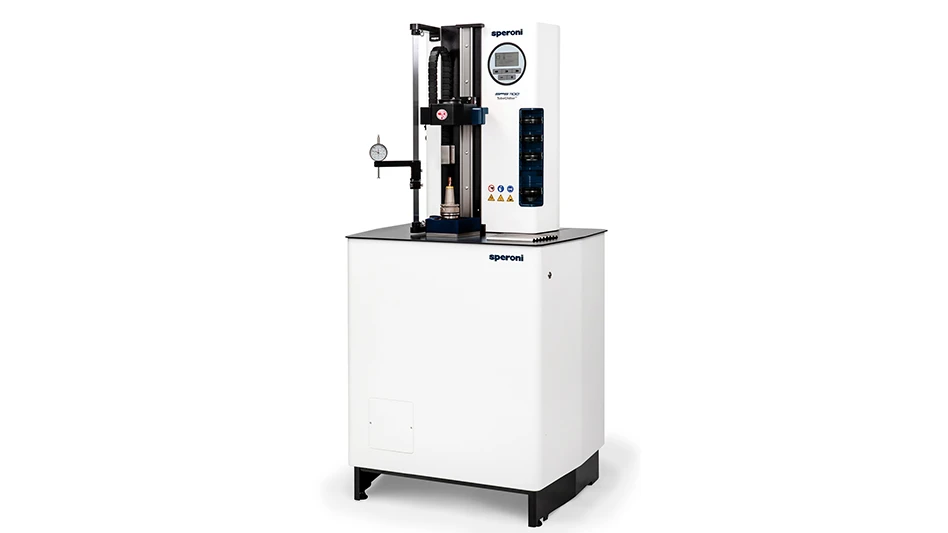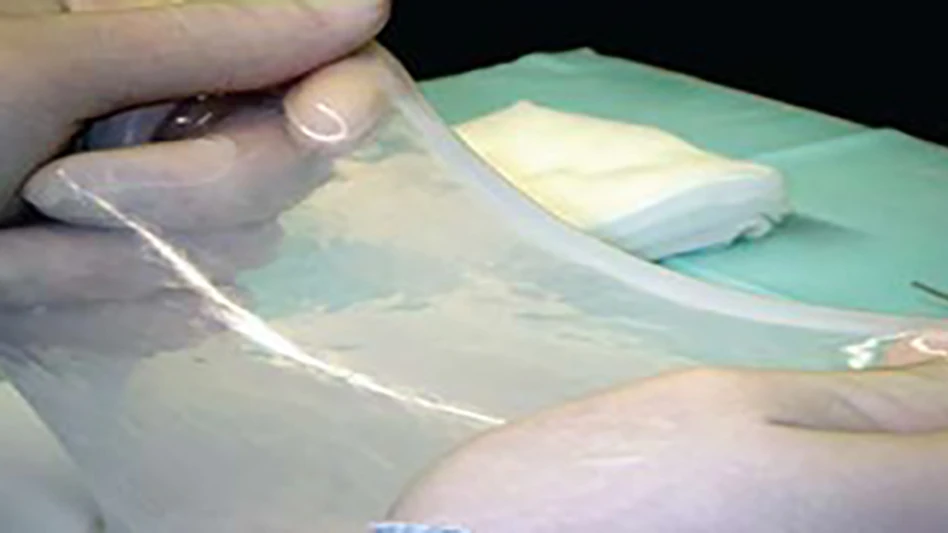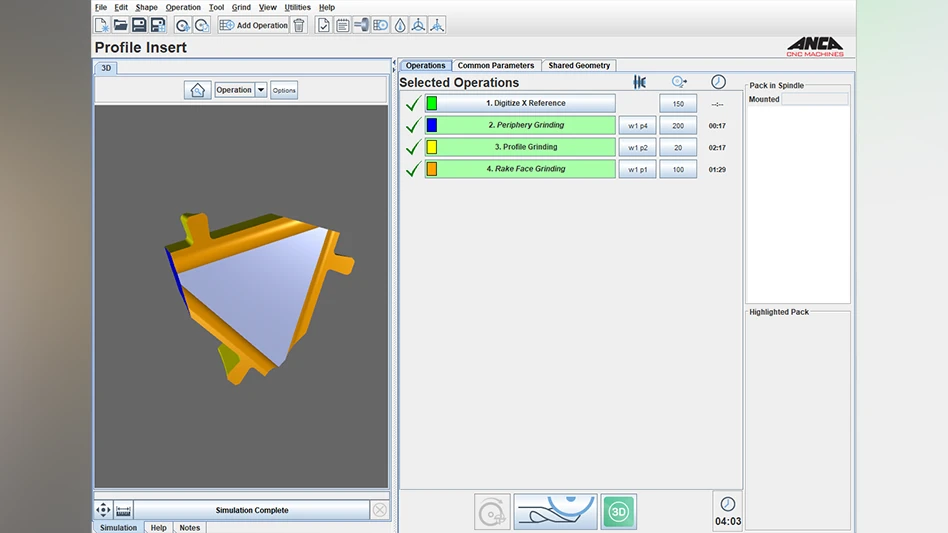The use of fluids during machining serves several functions, such as effective lubrication and cooling at the tool/workpiece interface, as well as effective flushing of the chips. Failing to efficiently evacuate the chips can result in subsequent occurrences of re-cutting, which tends to compress the removed material against the freshly machined surface and, to some extent, weld the chip fragments to the surface. This can also damage the quality of the surface finish.
 |
 |
| Iscar ISO Turn CBN inserts | Iscar’s JetHP line of special HPC tools includes Cut-Grip grooving tools, and Isoturn and Heliturn turning and facing tools. |
In contrast, lubricating fluids are susceptible to bacterial propagation and odor generation, which could cause serious health hazards.
Numerous other drawbacks associated with these fluids include the cost of procurement, disposal, maintenance, and labor. Stains on the part or contamination can also be problematic.
For flushing purposes, holemaking operations require the use of lubrication at the contact point of the drill with the workpiece material, aiming to eject the removed material from the hole. Lack of fluids will cause the chips to adhere to the hole walls and average roughness of the machined surface might be twice as high when compared to a wet operation. Lubricating the interface between the drill head and the walls of the hole can lead to a significant reduction of torque during the operation.
In milling and turning, transfer of the heat from the cutting zone toward the removed chips is an indicator of positive machining characteristics. Good chip design enables a deflection of 85% of the generated heat away from the cutting zone, while the remaining heat flows into the workpiece or dissipates into the tool. This heat generation phenomenon has a detrimental effect on the cutting tool in terms of tool life. During a milling operation, for example, the cutting edges tend to heat and cool as they enter and exit the piece being machined. These temperature fluctuations create a sequence of expansions and contractions that lead to fatigue stress and thermal cracks. The introduction of lubricating fluid often makes the situation even worse.
A long-lasting debate amongst research engineers revolves around the question of whether cutting fluid actually reaches the zone interfacing between the bottom side of the chip and the cutting tool. If they do, their effect is limited, assuming that they cool only the shearing vicinity. This hot/cold interaction only intensifies the temperature gradients and increases the thermal stress.
Regarding economical considerations, 20 years ago the purchase, management, and disposal of lubricating fluids accounted for less than 3% of the production costs. Today, in comparison, the same operations constitute 16% of the cost of the average job. In line with this significant trend, and with a notion that cutting tools only bear the relatively low cost of 3% on average, manufacturers are willing to accept slightly shorter tool life at the expense of eliminating the cost of buying and maintaining lubricating fluids.
Consequently, a growing number of manufacturers are turning to dry or nearly-dry machining solutions, with the intention to benefit from coolant cost savings or improved tool life. Dry machining refers to machining without any fluids, while near-dry machining or minimum-quantity lubrication (MQL) is the use of a minute amount of fluid that is applied directly to the cutting edge (either internally or externally). The near-dry machining features fluid vaporization during the process, leaving dry chips. The practice of dry, or near-dry machining, has already proved that much faster cutting conditions are successfully applied.
High-Pressure Coolant
High-pressure coolant (HPC) is the latest technology, used particularly for exotic and stainless steel materials. High pressure creates a localized stream of coolant at pressures that eliminate the formation of vapor and assist chip breaking into small segments.
The combination of coolant at high pressure – 70 bar to 140 bar – precisely targeting the cutting zone, provides advantages that are not available with conventional flood coolant. The coolant is delivered with enough force to reach the cutting zone as a liquid, not a vapor. In the liquid phase, it actually lubricates the cutting process as it quenches the molten chip, shattering it into smaller, more manageable pieces. Also, because of its internal flow path, HPC keeps the entire spindle, tool, insert, and workpiece cooler, leading to much longer tool and equipment life. In that sense, it works like the cooling system in an automobile engine.
Another benefit is that delivering coolant close to the secondary shear zone improves machinability of the material under high-speed conditions. Higher-pressure coolant, directed right at the cutting zone, creates smaller, more manageable chips, whether the material is titanium, Inconel, or steel. Directing the coolant right to the cutting zone is the key. This is the laser approach to coolant deployment, not the floodlight approach.
An example of some Iscar HPC tools are the JetHP line that includes Cut-Grip grooving tools, Isoturn and Heliturn turning and facing tools, Tang-Grip parting and grooving tools, and Pentacut grooving, recessing, and parting tools. They are useful for turning applications that include outer and inner diameter work on a variety of components.
Coolant pressures have ranged up to 400 bars, but most applications have been in the 70 bar to 100 bar range.
 |
 |
| JetHP tools are useful for ID and OD turning applications. | Cut-Grip grooving tools are from the JetHP line of special HPC tools. |
HPC tools are custom designed to operate at these extreme pressure and cutting rates. They deliver a higher performance level than their conventional internal coolant counterparts made for lower pressure service.
High-pressure coolant systems deliver numerous production benefits:
• Increased productivity – High-pressure coolant removes heat and deflects chips from work surfaces, allowing for higher feedrates and faster spindle speeds;
• Higher quality – More efficient chip removal, higher feedrates, faster spindle speeds, and reduced tool wear in turn boost part quality and surface finish; and
• Longer tool life – High-pressure coolant eliminates heat and chips and reduces tool wear.
Substrate, Coatings
The method of dry/near-dry machining has been favorably recognized in the past few years and Iscar strongly supports the adoption of green machining techniques, with the added value and benefits of cost reduction. With that in mind, the latest technology of cutting tool materials, such as advanced coated carbide, ceramics, cermets, cubic boron nitride (CBN), and polycrystalline diamond (PCD) has been developed.
The sub-micron grain structure of the solid carbide substrate provides the retention of cutting edge integrity – even at high cutting temperatures – while accommodating a sufficient softening effect to combat deformation and resist cratering. The high cutting temperatures, which occur during dry machining, tend to slightly soften the carbide structure, which, in turn, increases its toughness, helping prevent any potential chipping while prolonging tool life.
Using polycrystalline boron nitride (PCBN) cutting tools also provides a successful alternative to dry machining. Abrasive technology features PCBN tools for turning, boring, and milling applications in a form of braze-tipped or solid PCBN inserts.
The PCBN features a close resemblance to diamond hardness with a considerable amount of abrasion resistance, combining both a high degree of toughness and hot hardness. All of these properties make PCBN the most suitable cutting tool material for machining hardened steels, cast irons, and super alloys.
A recently launched Heliturn IS8 ceramic inserts, with a molded chipformer, combines the advantage of the Heliturn tangentially clamped insert system with the ceramic grade and a sophisticated molded chip former.
The tangential clamping is most important when using ceramic inserts due to the ability to eliminate any bending forces exerted on the insert.
Dry Machining, Coolant
Despite the growing popularity of dry machining and MQL methods, machining some materials essentially requires the use of cutting fluids. Machining aluminum has to be carried out with the use of high pressure coolant for the prevention of built-up-edge phenomenon. In addition, machining high temperature and nickel based alloys also requires the use of copious amounts of coolant for the prevention of strain hardening of the sub-surface layers. Deficiencies such as chipbreaking, exhibited when machining stainless steel, can be solved by the use of a coolant stream. In order to support the implementation of dry machining, the recently introduced the 3P Sumo Tec, features premium tungsten carbide grades for drilling, milling, turning, and grooving. The new grades extend tool and insert life as a result of innovations in the substrate and in the CVD and PVD coatings.
The PVD process is composed of Iscar’s Al-Tec coating technology, while the CVD coating is based on its Alpha-Tec technology; both of which have been shown to provide superior wear resistance. In an additional process, another layer is deposited on top of the PVD and CVD coatings to provide a very even, low-stress layer that improves tool life further.
The smooth surface contributes to uninterrupted chip flow resulting in less friction and heat generation. The new process also improves toughness and chipping resistance, reducing friction and built-up edge, which, in turn, prolongs tool life at elevated machining speeds and feeds for all types of workpiece materials.
Iscar Metals
Arlington, TX
iscar.com

Explore the October 2010 Issue
Check out more from this issue and find your next story to read.
Latest from Today's Medical Developments
- Teleflex sells acute care and urology businesses for $2.03 billion
- HANNOVER MESSE: Where research and manufacturing meet
- What’s next for the design and manufacturing industry in 2026?
- Arcline to sell Medical Manufacturing Technologies to Perimeter Solutions
- Decline in German machine tool orders bottoming out
- Analysis, trends, and forecasts for the future of additive manufacturing
- BlueForge Alliance Webinar Series Part III: Integrate Nationally, Catalyze Locally
- Robot orders accelerate in Q3





